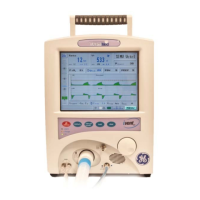Appendix A: Glossary
193
Term Definition
Adaptive Bi-Level
A combination of face mask and invasive modes of
ventilation utilizing two levels of pressure for each
breath, P
High
for Inspiration and P
Low
for Expiration and
Pause.
Adaptive Peak Flow
TM
An Inspiratory Peak Flow Rate determined and delivered
to meet the target mandatory tidal volume, while
maintaining a 1:2 I:E ratio.
Adaptive I. Time
TM
A ventilator determined inspiratory time to maintain a
1:2 I:E ratio.
Airway Pressure
Pressure measured at the proximal airway of the
breathing circuit by the flow sensor. (Unit of measure
cmH
2
O).
Alarm
A combined audible and visual notification generated
when the ventilator detects an operating condition
requiring immediate operator intervention.
Alarm Pressure
Adjustable pressure level at which a high-pressure
alarm occurs.
Apnea
Apnea occurs when the patient fails to receive or
perform a breath during a period of 20 seconds or as
set.
Apnea Mode
A ventilation mode that automatically starts when a
patient apnea is detected.
Assist Breath (patient
initiated mandatory
breath)
Any positive pressure breath that is initiated by the
patient, and controlled and terminated by the ventilator.
(Available in Assist / Control and SIMV modes).
Assist / Control Mode
A mode of ventilation in which the patient receives a set
rate of mandatory breaths. The patient may trigger
some or all of the breaths. The total measured
respiratory rate may be greater than the set rate.
Auto Start
A safety mode of ventilation that ventilates in a Pressure
mode and begins when resistance is detected at the
end of startup phase or when -2 cmH
2
O pressure is
detected in the Standby mode.
Baseline
The pressure at which the patient is maintained by the
ventilator between breaths. PEEP or CPAP.

